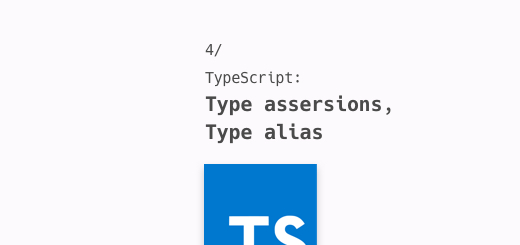Back to Posts
2017년 11월 18일
4/ 타입추론, Type assertions, Type alias

타입스크립트 정리 글은 이웅재님의 강의 와 강의록 을 참고하여 작성하였습니다. (짱짱) 오류가 있다면 언제든지 댓글 부탁드립니다.
목표 이 포스팅과 interface 포스팅에서는 타입을 명시하는 방법을 배웁니다. 타입을 명시하지 않아도 추론이 가능하며, 강제 타입선언, 별명을 붙여가며 타입을 선언하는 방식 등을 배웁니다.
1. let과 const의 타입 추론
let a: string = '진호';
let b = '승민';
const c: string = '나영';
const d = '슬기'; // 리터럴 타입- const는 프리미티브 타입은 다른 값으로 못 바꾸고, 레퍼런스타입은 다른 레퍼런스타입을 가리키지
못하게 하는 것인데, 타입스크립트에서는
리터럴 타입이라고 하는 것으로 타입까지 강제해버린다. - 즉 const에서 타입없이 선언될 경우 타입 추론에 의해서 할단된 값이 타입으로 된다. (리터럴 타입) ex.
위에서
const d = '슬기'에서 d는const d:'슬기'라고 뜨고, 슬기라는 리터럴 타입으로 된다.
재할당 redeclare
- let은 재할당(redeclare)이 가능하다.
- const는
- 레퍼런스 타입은 레퍼런스 값이 바뀌는 것을 허용하지 않고, 속안의 프로퍼티 바꾸는 것은 허용된다.
- 프리미티브 타입은 재할당이 아예 불가능.
보통은 const를 사용하며, let을 쓰면서 명시적으로도 값이 바껴지는 변수라고도 표시한다.
2. Type assertions (assertions:‘단언’)
- 형 변환과는 다르다. 형 변환은 : 실제 데이터 구조를 바꾼다.
'타입이 이것이다'라고 컴파일러에게 알려주는 것을 의미한다. 예_넓은 범위의 타입이 (union타입) 어떤 상황에서 고정이 되어야할 경우, 타입 어셜션으로 타입을 강제해 준다.- 방법은 2가지가 있다.
- 변수 as 강제할 타입
<강제할타입>변수
let someValue: any = 'this is a string';
let strLength: number = (<string>someValue).length;
let strLength: number = (someValue as string).length;
/*
1. 주로 넓은 타입에서 좁은 타입으로 강제하는 경우가 많다.
2. jsx 에서는 as 를 쓴다.
*/3. Type alias (alias:‘별명’)
타입에 별명을 붙인다고 생각하면 된다.
- 타입이 생기는 것이 아니라, 따로 이름을 붙여주는 것이다.
- interface가 유사하지만 interface처럼 쓸수 없는 경우가 있다.
- Primitive나 Union Type, Tuple 같은 타입에서 쓴다. 보통 Primitive 타입은 .. 많이 안쓴다. (number나 string을 구지..)
- 만들어진 타입의 refer로 사용하는 것이지 `타입을 만드는 것은 아니다.
type + 별칭
// Aliaing Primitive
type MyStringType = string;
const str = 'world';
let myStr: MyStringType = 'hello';
myStr = str;
// string에 'world'라는 별명을 주었다.
// 별 의미가 없다..// Aliaing Union Type
let person: string | number = 0;
person = 'Mark';
type StringOrNumber = string | number;
// StringOrNumber이라는 타입별칭을 붙였다.
// 별칭 붙일 때는 앞에 type + 별칭
let another: StringOrNumber = 0;
another = 'Anna';
/*
1. 유니온 타입은 A 도 가능하고 B 도 가능한 타입
2. 길게 쓰는걸 짧게
*/// Aliaing Tuple
let person: [string, number] = ['Mark', 35];
type PersonTuple = [string, number];
let another: PersonTuple = ['Anna', 24];
/*
1. 튜플 타입에 별칭을 줘서 여러군데서 사용할 수 있게 한다.
*/3-1. Type alias와 Interface와 차이점
보통은 interface와 class등을 자주 사용하기 때문에 alias 쓰는 타이밍이 초반에는 많이 없다. interface를 사용하다가 굳이 사용할 필요가 없는 순간에 alias를 쓰면 된다.
- 오류 메세지 타입스크립트가 컴파일을 시도할때 오류가 나올때, Alias라는 이름으로 알려주지 않고 타입 자체로 알려준다.
type Alias = { num: number };
interface Interface {
num: number;
}
declare function aliased(arg: Alias): Alias;
declare function interfaced(arg: Interface): Interface;
/*
1. type alias 는 object literal type 로
2. interface 는 interface 로
*/- 상속을 받을 수는 있지만 상속을 할 수는 없다.
- 당연한건 type alias 끼리는 extends, implements 불가
- interface extends type alias 가능
- class A implements type alias 가능 = A라는 클래스는 type alias 인터페이스를 구현할 수 있다.
- class A extends type alias 블가 (interface 도 마찬가지) = A라는 클래스는 type alias를 상속받지 못한다.
- 마치 interface 처럼 동작한다.
- 클래스 선언문의 implements 뒤에 인터페이스를 선언하면 해당 클래스는 지정된 인터페이스를 반드시 구현하여야 한다.
type PersonAlias = {
name: string;
age: number;
}; // type alias
interface IPerson extends PersonAlias {} // 가능
let ip: IPerson = {
name: 'Mark',
age: 35,
};
class PersonImpl implements PersonAlias {
name: string;
age: number;
hello() {
console.log('안녕하세요');
}
} // PersonImpl라는 클래스는 PersonAlias라는 인터페이스를 구현하겠다.
let pi: PersonImpl = new PersonImpl();
pi.hello();
class PersonChild extends PersonAlias {} // 불가능- extends와 implements의 차이
class A extends B라고 하면 A는 B라는 클래스를 상속 받아서 +a 시키겠다는 뜻.class A implements C라고 하면 A는 C라는 인터페이스를 구현하겠다~ 라는 뜻입니다.
참고링크
- http://gdthink.blogspot.kr/2006/06/extends%EC%99%80-implements%EC%9D%98-%EC%B0%A8%EC%9D%B4.html
- http://poiemaweb.com/typeScript-interface
Related
2018년 12월 9일
2018년 11월 25일
2017년 11월 28일
2017년 11월 27일
2017년 11월 26일